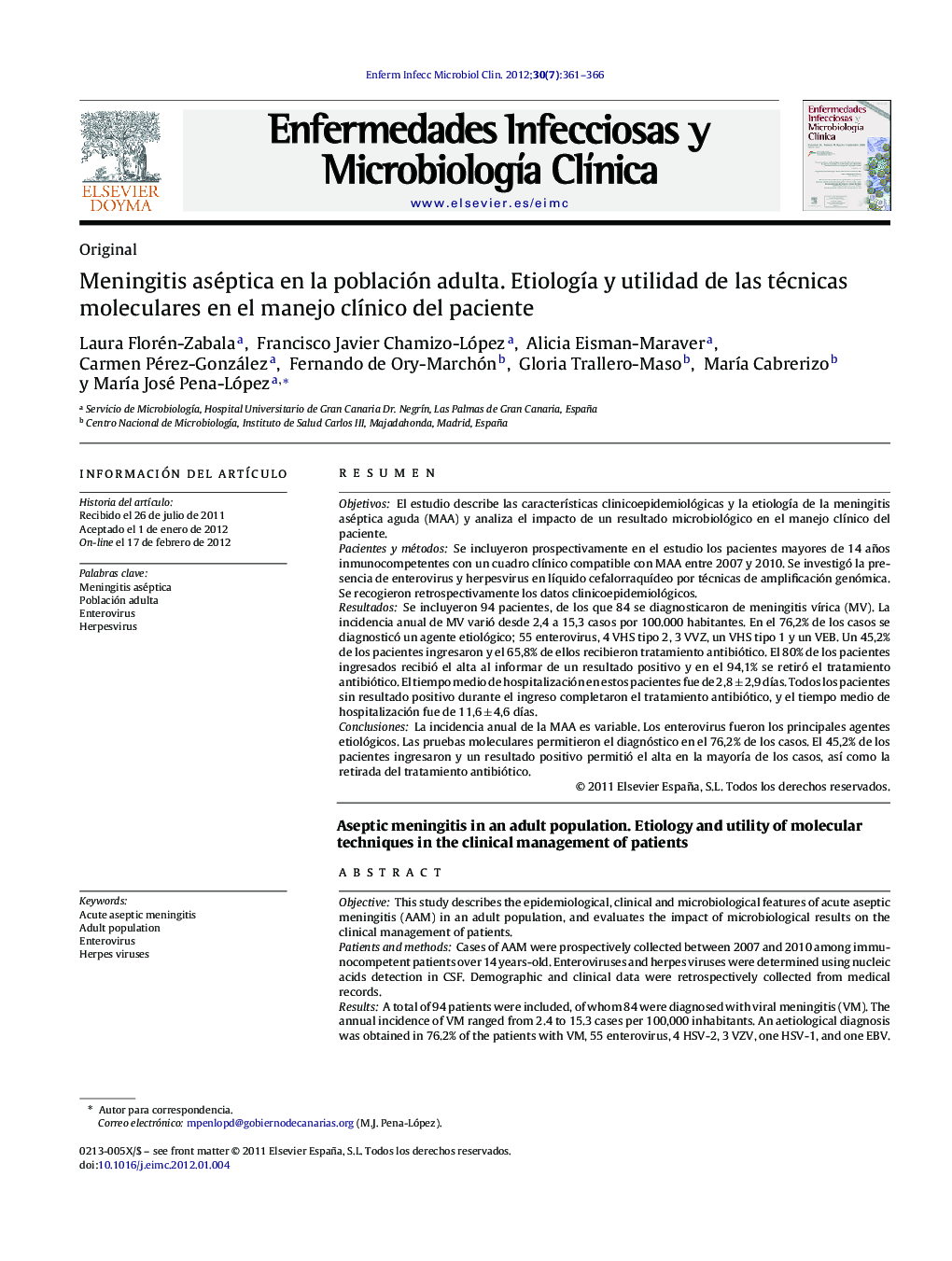| کد مقاله | کد نشریه | سال انتشار | مقاله انگلیسی | نسخه تمام متن |
|---|---|---|---|---|
| 3401324 | 1222659 | 2012 | 6 صفحه PDF | دانلود رایگان |

ResumenObjetivosEl estudio describe las características clinicoepidemiológicas y la etiología de la meningitis aséptica aguda (MAA) y analiza el impacto de un resultado microbiológico en el manejo clínico del paciente.Pacientes y métodosSe incluyeron prospectivamente en el estudio los pacientes mayores de 14 años inmunocompetentes con un cuadro clínico compatible con MAA entre 2007 y 2010. Se investigó la presencia de enterovirus y herpesvirus en líquido cefalorraquídeo por técnicas de amplificación genómica. Se recogieron retrospectivamente los datos clinicoepidemiológicos.ResultadosSe incluyeron 94 pacientes, de los que 84 se diagnosticaron de meningitis vírica (MV). La incidencia anual de MV varió desde 2,4 a 15,3 casos por 100.000 habitantes. En el 76,2% de los casos se diagnosticó un agente etiológico; 55 enterovirus, 4 VHS tipo 2, 3 VVZ, un VHS tipo 1 y un VEB. Un 45,2% de los pacientes ingresaron y el 65,8% de ellos recibieron tratamiento antibiótico. El 80% de los pacientes ingresados recibió el alta al informar de un resultado positivo y en el 94,1% se retiró el tratamiento antibiótico. El tiempo medio de hospitalización en estos pacientes fue de 2,8 ± 2,9 días. Todos los pacientes sin resultado positivo durante el ingreso completaron el tratamiento antibiótico, y el tiempo medio de hospitalización fue de 11,6 ± 4,6 días.ConclusionesLa incidencia anual de la MAA es variable. Los enterovirus fueron los principales agentes etiológicos. Las pruebas moleculares permitieron el diagnóstico en el 76,2% de los casos. El 45,2% de los pacientes ingresaron y un resultado positivo permitió el alta en la mayoría de los casos, así como la retirada del tratamiento antibiótico.
ObjectiveThis study describes the epidemiological, clinical and microbiological features of acute aseptic meningitis (AAM) in an adult population, and evaluates the impact of microbiological results on the clinical management of patients.Patients and methodsCases of AAM were prospectively collected between 2007 and 2010 among immunocompetent patients over 14 years-old. Enteroviruses and herpes viruses were determined using nucleic acids detection in CSF. Demographic and clinical data were retrospectively collected from medical records.ResultsA total of 94 patients were included, of whom 84 were diagnosed with viral meningitis (VM). The annual incidence of VM ranged from 2.4 to 15.3 cases per 100,000 inhabitants. An aetiological diagnosis was obtained in 76.2% of the patients with VM, 55 enterovirus, 4 HSV-2, 3 VZV, one HSV-1, and one EBV. Forty five per cent of patients were admitted to hospital and 65.8% of them received antibiotic treatment. A positive result prompted immediate discharge of 80% of inpatients and discontinuation of antibiotic therapy in 94.1% of them. The median duration of admission to hospital in these patients was 2.8 ± 2.9 days. Patients without available results during admission completed the antibiotic treatment, and the median hospital stay was 11.6 ± 4.6 days.ConclusionsThe annual incidence of AAM is variable. Enteroviruses were the main aetiological agent. Molecular tests revealed the aetiology in 76.2% of cases. Almost half of the patients required hospitalisation, and in these cases a positive result can lead to the immediate discharge of patients, and the diagnostic and therapeutic interventions can be reduced.
Journal: Enfermedades Infecciosas y Microbiología Clínica - Volume 30, Issue 7, August–September 2012, Pages 361–366